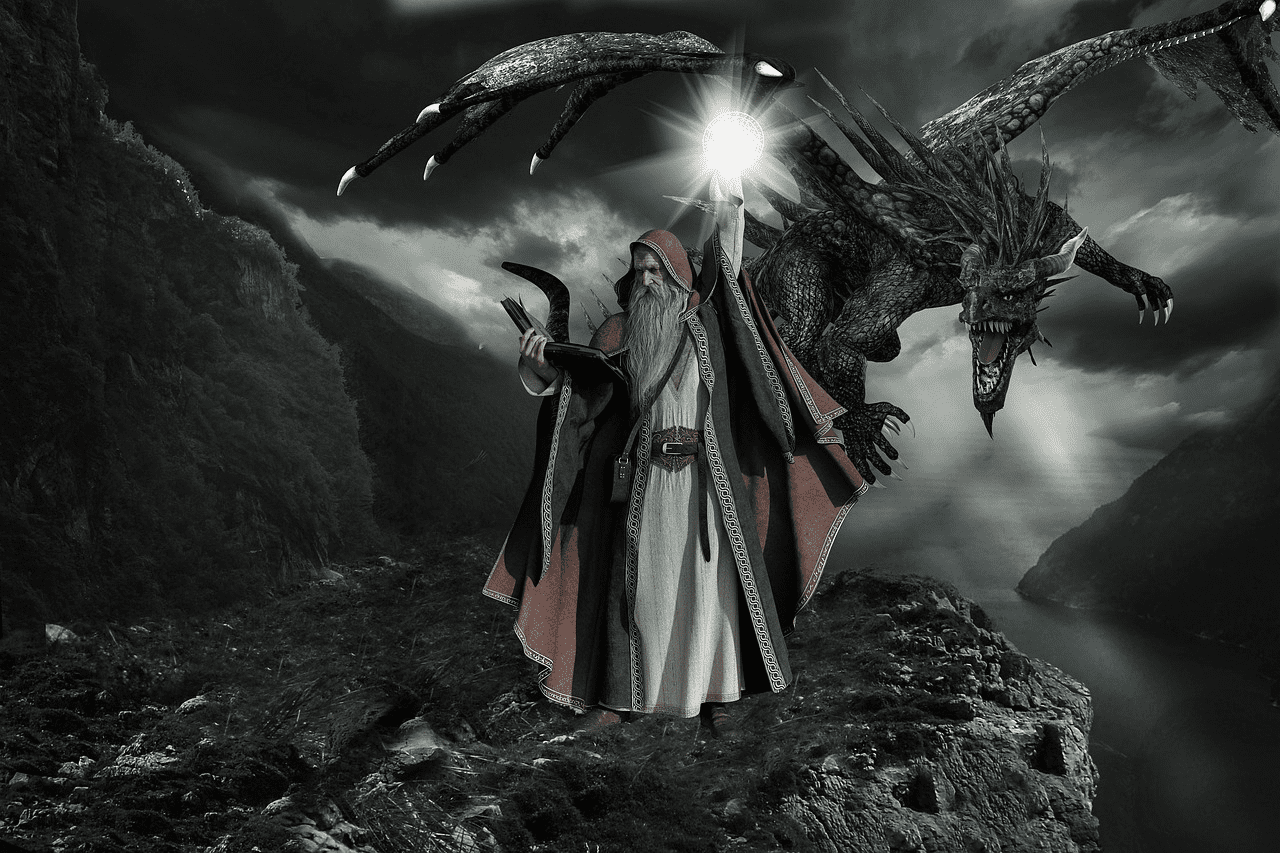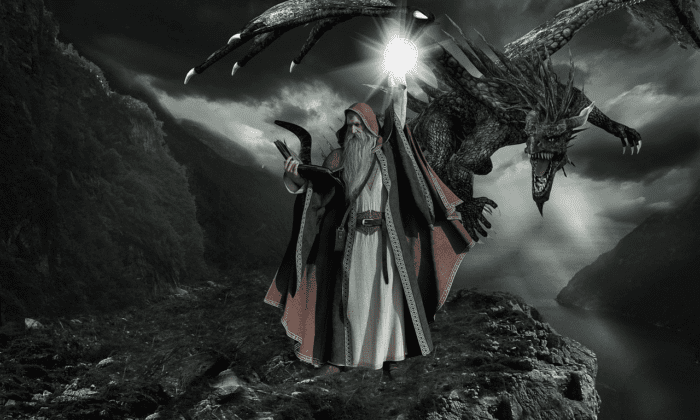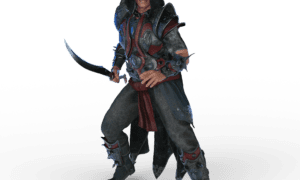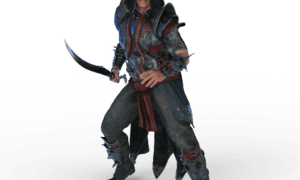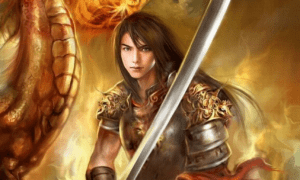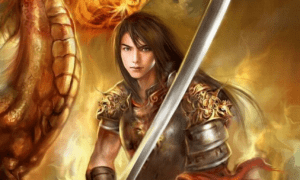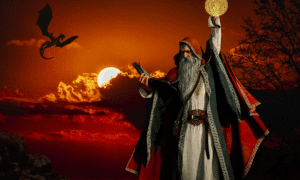Dragons’ Folk, by J. W. Cassandra
A Long Time Ago
A long time ago, when people corrupted things on Earth, after a vast destruction, there was hardly anyone left who could exist. As the heavenly connection was broken, people were unhappy, clumsy, and ignorant, stumbling in the dark in comparison to their old knowledge. At least, who remained yet…
Heavenly Father’s Will
The Heavenly Father felt pity in his heart the misery of the earthly people, and from the Heavenly Residence of Dragons he sent to the earth the benevolent, erudite dragons, blessed with great spiritual abilities, to teach them.
The dragons did even their best, taught humans how to keep goats, milk, make clothes, and anything imaginable. People started working, increasing and getting smarter.
Decision of the Evil Spirit
One fine day, however, the Evil Spirit, who was also controlling the world, noticed that the people were in smooth waters, so he sent the evil dragons to Earth.
The evil dragons captured their victims flying, taking them up into the air and throwing them down, then either catching them or letting them fall… The benevolent dragons in such cases flew under the victims and took them back to their residence.
Protection
When too much had happened that had amassed the criminal record of malicious dragons, the benevolent dragons taught people to defend themselves: they handed them over from their own scales to protect them. These scales were worn by the people around their necks, and if there was trouble, they only touched them: in this case, the grantor benevolent dragon appeared immediately there to help.
Dragon Fighting Methods
But a dragon couldn’t always get there on time because more people could ask for his help, so they taught people how to fight a dragon. They could not teach everyone only the exceptionally skillful, brave, and clever men. Women not, or only exceptionally, as their figure had already doomed them to loss.
Ways of dragon fighting included flying, the dragon’s tail blow, which smashed even a mountain in two with a single, say so, soft blow, the breath of fire, the multiplication, and the attack from all directions at once. The roar uttered by the evil dragons served to intimidate, but most of the time it was effective in itself because there had not lived a hero whose heart would not tremble on hearing that roar.
Dragon Conquering Weapon
Anyone who stood up against the dragon needed weapons that would surely annihilate the dragon: such weapons were made of special metals with sharpened edges in all directions, but the most effective was the diamond-edged weapon against evil dragons. The benevolent dragons also taught these heroes to imitate dragon claws, but most of all they wanted to show them the ways of thought warfare. But it failed because these people were not in contact with Heaven, precisely because of the mistake they made.
Arrival of Shamans
Then came the shamans from the Celestial Residence of the Shamans, who established the celestial connection, and the protection of a “village” or a community depended entirely on their celestial connection. The stronger they were in such an area, the more they knew, the more effectively they could protect members of the community. However, they were not warriors. Their role could only be protective and restorative.
The benevolent dragons in the end were in contact only with them when they got a good beating in tug of war.
Dragon Talisman
The good dragons, when they perished on Earth, entrusted the shamans to use the remnants of their bodies for protection and healing. Therefore, the shamans cut down the bodies of the good dragons, ground their bones into dust, and put this dragon-grind into talismans, which they wore around their necks; they used for protecting the dragon claws, teeth, scales, and every remnants of the benevolent dragons.
Dragon Statues
Bones ground to dust, sometimes scales or claws, teeth were inserted into dragon statues that were shaped in a small form just as the good dragon was. This protected the inside of the tent, the home fire, the family and the cattle. The magic power was attributed, on the one hand, to the remains of a dragon ground to dust and, on the other hand, to the material from which the statues were made: to gold and precious stones. The eyes of the benevolent dragons were green, this was laid out of emerald or malachite.
The eyes of the evil dragons were red, if such a statue was made, it happened with the aim of taking away the power of evil. In such cases the evil dragon was moulded of gold, his eyes were stoned with ruby, his scales were made of emerald, his claws were painted, and the remnants of the good dragon were placed inside the statue.
The benevolent dragons had the same knowledge and the same abilities as their evil companions, only they helped people with them, not did them any harm. They were worsted only in the battle against them because the Heavenly Father wanted it so. And he wanted this so that people would be transformed.
ProtectionAagainst Evil Eye
Humans were able to defend themselves effectively against evil eye, disease, and attacks coming from heaven with dragon remains and statues containing them. They also used these remains for healing, and the spiritual power of the remains most often helped them. Initially, all people were competent in this kind of defense, but they more and more avoided dragon caves, because when the evil dragons got wind of the deeds of the good dragons and found their hiding place, they too searched for such caves for themselves, and disguised themselves: they took the shapes of the benevolent dragons on themselves for betraying and ravaging unsuspecting and unprotected people.
Thus it soon became customary for a community, for a a large family that the shaman, learned to recognize the shapeshifting tricks of evil dragons, to defend themselves with the help of Heavenly Father, and, thoroughly equipped with protective amulets, to go alone to the benevolent dragons for advice and assistance if it was a must.
Magic Power
The shamans at this time were able to take over the abilities of the dragon through the remnants of the benevolent dragons that protected them, so they immediately recognized all shapeshifters, they were able to shift their shape, as well as to fly on their own, to fight from heaven and earth, from every direction at once, to breathe flames, to make earthquakes, flood, to start a tidal wave, to make crumble rocks and mountains. Taking the power of the good dragon, they could even defeat the evil dragons.
Various Dragons
However, not all dragons were the same, there were also differences between evil and good dragons: each had different knowledge, over the general abilities, they had also different ones that I had already unfolded. The stronger, the more powerful a dragon was, the more he knew, the more abilities he had that he could do good or bad, and the more lives he had.
All species of dragons could live for up to the lifetime of a thousand lives, they could come to Earth with at least one life, but such a dragon was easy to defeat.
Various Shamans
According to the differences between the dragons, the shamans also differed from each other: the more they knew, the more abilities they could use, the more powerful dragons they had to keep in hand or to defeat. Of course, they enjoyed the protection of a benevolent dragon with the appropriate knowledge and abilities through dragon remains.
Dragon-tooth Sowing
The shamans were especially vigilant of the dragon’s teeth: for by their power they learned that the dragons on the earth would emerge from the sowing of their teeth, and that the evil dragons should not multiply too much, they quested for the dragon-tooth sowings and destroyed them both concerning physically and their celestial power.
Before the appearance of shamans, common people had not known this, even if they saw a dragon-tooth sowing, they could not know what it was, and so they were not able to distinguish them from each other. Yet immediately after springing it was very easy to distinguish them: the shoots of the good dragons were serrated and fresh green, those of the wicked turned red at their end, the rest turned green. From this initiative, reminiscent of some strange plant, the dragon then evolved with a sudden speed: in the course of a single day and night.
Their lifetime on Earth was much longer than that of humans: an average of three to four hundred years, but there were five hundred-year-old, in exceptional cases, even thousand-year-old dragons, as well.
Where did the dragon’s tooth come from?
Since the earthly shape of the dragon was a dragon snake or lizard around this time, it sloughed two to three times a year. At such times, he also shed his teeth and made grew new ones in a single day. From his jaw stood many, closely spaced, pointed, serrated teeth that he could use as a weapon, a formidable weapon.
Well, out of these sprang the dragons, both the benevolent and the evil. After a while, they covered the Earth with barely enough space. It was then that the evil dragons attacked the good ones, who also disappeared from the surface of the Earth after the losing battle. The reproduction of dragons has been successfully inhibited by shamans because fewer and fewer evil dragons have since sprung. Thus, they were able to fight them more easily, as they were forced back into the waters, into the brimstone caves of the mountains, into the air, and their frightening roar less often froze the blood in the veins of animals and humans.
Dragonhead
Dragon tooth sowings clung not only to their earthly but also to their celestial roots, so they had to be eradicated both in order for their struggle to succeed. To destroy the earthly roots, dragonhead was used, which appeared on Earth when dragons appeared, and since dragons can take on human bodies, this grass has been perished. It was a peculiar-looking grass: a thick, strong blade of grass on which green and red scale-like nodules straggled. If this was mixed with some garlic and sprinkled on the dragon-tooth sowing, the sowing was destroyed. Garlic helped and supported the final destruction of the sowing. The shaman used the celestial power and knowledge of the good dragons to destroy the growing sowing.
However, the shamans spoke strictly of the way of this destruction to their only successor, as humans were not competent to understand and receive such knowledge. And the reason was that the Golden Age was followed by a human race in a rather rudimentary state that lost its celestial connection, knew nothing of its existence, and was unable to learn it.
Sorcerers, Named ’Taltos’ [1]
The fight against dragons on the part of the shamans did not end with the destruction of dragon-tooth sowings, but they trained young people suitable for the armed struggle against the dragon, and with the power of the heavens they helped him in the form of some animal, mostly a horse. Hence the fact comes from, that the shaman, who helped the hero in a sorcerer named ’taltos’ or similar form, could give more life him by blowing on the dead and bringing him back to life, either anointing him with various woundworts, or sprinkling him with the water of life, and pouring strength back into him, and he also handed the hero a part of his knowledge to help him win.
The manner of resurrection depended on the shaman’s power, knowledge, and celestial power, and the pouring of his power into the chosen youth rested solely on the shaman’s celestial power.
If the shaman was powerful enough, he could resurrect the young man as many times as possible and he could make him even stronger after each resuscitation. But there was always a limit he could not cross: once the young man’s soul was darkened, he could no longer be resurrected. In such cases used to “change the color” of the scarf given to the young man’s sweetheart, or to “become blood-coloured” in the tales, because they guard this change by these descriptions.
Shamanic Power
The shaman who truly possessed power always knew when the darkening of his own soul would occur, and if he felt it, he had given all his knowledge and power to the young man before that: in fact, the shaman’s spirit had moved into the young man.
Thus the young man could successfully enter the fight against any evil dragon, for whoever warrior defeated death, he became invincible, no matter how many lives the dragon had.
His abilities became identical to those of the shaman, from the shape-shifting to the continual resurrection all shaman tricks were known for him and he was able to apply and while he lived on Earth, he gained a reputation by destroying evil dragons that shook the hearts of all evil dragons.
Many of these shaman warriors became on Earth because of the abuses of evil dragons, and many of these shaman warriors took up the fight with dragons in the water, in the air as well.
The slaughter of dragon heads did not develop among dragon-killing shaman-warriors because they were bloodthirsty, but they were motivated by the spirit of the shaman who lived in them, knowing exactly which dragon head would be cut off from the tribe at death, their teeth won’t ever spring from the soil any more.
Thus, the shaman warriors slowly exterminated the evil dragons, and it became impossible for the dragons to survive in the form of a dragon lizard or snake, or even a dragon.
Vulnerable Spots
Above all, people honoured the shaman warriors, and used the shaman-enchanted power of amulets or talismans of the cut off dragon heads, claws, and scales to defend themselves. Thus, the warriors, assisted by a shaman in the fight against the dragons, learned the vulnerable spots of the dragons through amulets or talismans made from the remains of the evil dragons, they absorbed their strength and knowledge, and turned against them, thus defeating them.
Shaman Amulets
And the shamans divided the talismans among the sons of common people, into what they always placed among the remnants of the evil dragons, also those of benevolent dragons, and a piece of their own souls. These remnants and talismans were placed in golden dragon statues, and the dragon was made once with green then with red eyes. This, broke the power of the evil dragons, as well, for when a statue of an evil dragon was made, it always contained a piece of the soul of the strongest shaman and a small remnant from the benevolent dragons – thus the power of evil was destroyed.
These dragon statues were then placed by members of the Folk of the Moonbeams’ Silver Warriors at the holy place of their tents to protect them and their families from all evil eyes.
Dragons’ Folk
This is how the shamans were able to conquer the evil dragons, and thus the four earthly folk evolved from the celestial people who came from the Dragons’ Celestial Residence and who were collectively named the Dragons’ Folk: the the Moonbeams’ Silver Warriors, the Orient Aurora’s Rays’ Folk, the Great Bear’s and the Little Bear’s Warrior Folk.
These four peoples were and are still able to defeat evil dragons not only in earthly battles, but also in celestial fights, but this is about completely different kinds of battles than before, because by that time the dragons had also been transformed, and these battles namely shaman fights between the shaman warriors, the Dragons’ Warriors versus the evil dragons represent a new epoch in history of humans and their folks in this form.
Written: 05/03. 2004., by J. W. Cassandra
Translated: 28/07. 2021., by J. W. Cassandra
[1] The word is missing in English. The figure of a kind of shamans lives in Hungarian folklore, the person named ’taltos’ was born for this life with a tooth or with 6 fingers or something like this and they had supernatural power and abilities like shamans. Origin of the word: according to Hungarian Etymological Dictionary, the word is an ancient Ugric heritage, among others, the Ostyak language had a word ’tolten’ with meaning ’magic power’. From this ancient word we have the origin of our word ’táltos’, with a suffix from a noun. Its original meaning could have been ’having magic power’. Our folklor has a figure of a horse named ’táltos’, as well, it’s a steed with magic abilities and that of power. It can even talk as a human and fly, as well.
